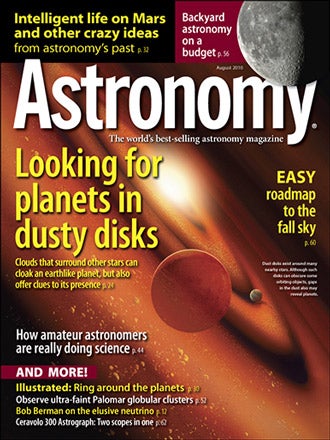
Editor David J. Eicher gives a video tour of the August 2010 issue
Waukesha, Wis. — Dust fills our solar system, its source including comets warming as they near the Sun, asteroid collisions, and more. These activities add up to a debris-filled complex stretching from the Sun’s corona to the Kuiper Belt and beyond. Astronomers call the inner part of this dust cloud, from the Sun to the asteroid belt, zodiacal dust. Yes, it creates the beautiful zodiacal light we see on the horizon before sunrise and after sunset. But it also obscures Earth from viewpoints outside our solar system. Likewise, “exozodiacal dust” shrouds planets outside our solar system, becoming the scourge of planet hunters worldwide.
In “How to find planets hidden by dust,” scientists Marc J. Kuchner and Christopher C. Stark explore the problems exozodiacal dust causes for astronomers and how they are now trying to use the debris to instead provide clues to the planets the dust shroud may be hiding.
A discovery about Earth’s relationship with zodiacal dust led to Kuchner and Stark’s belief that exozodiacal dust could help, rather than hinder, planet hunters. “The zodiacal dust cloud bears Earth’s signatures: a ring around the Sun with a radius of 1 astronomical unit that matches Earth’s orbit,” they write. “And that’s just for Earth, a relatively small planet on a tidy circular orbit. Perhaps extrasolar planets could create similar rings around their host stars.”
To learn more about exozodiacal dust and how it impacts our search for earthlike worlds, pick up the August issue of Astronomy, on newsstands July 6.
“How amateur astronomers are really doing science”
The number of eyes (and cameras) on the sky has increased rapidly in the past decade. And it’s not just because more people are taking up astronomy as a profession or more observatories are developing every year. These days, not much that is reasonably bright escapes notice because amateur astronomers are out in droves studying the sky. And they are discovering near-Earth objects, measuring variable stars, and finding supernovae like never before. In “How amateur astronomers are really doing science,” astronomer Brian Skiff shares the contributions of a variety of backyard observers and explains how you too can get involved in the science of astronomy.
“Backyard astronomy on a budget”
The economy may be recovering slowly from its rapid decline of the past two years, but it has had lasting effects on how people spend their money for leisure activities. And let’s face it, astronomy is not perceived as a cheap hobby. But in truth, it doesn’t cost a lot to get started stargazing. To help newcomers get the most for their money under the night sky, Contributing Editor Glenn Chaple wrote “Backyard astronomy on a budget,” which includes tips on what to buy, what can wait, targets to start with, and more.
August night-sky events visible without optical aid
August 10: Mars, Saturn, and Venus form a near isosceles triangle in Virgo the Maiden.
August 12: With the Moon out of the sky, observers can expect to see up to 100 Perseid meteors per hour.
Also in the August 2010 Astronomy
- “Illustrated: Ring around the planets” — Saturn sports spectacular rings, but all the gas giants in our solar system display ring systems.
- “10 crazy ideas from astronomy’s past” — Some theories excel at explaining the universe. Others, like the ones here, are entertainingly ridiculous.
- “Challenge yourself with the Palomar globular clusters” — Pull out your large scope, head to a dark site, and test your skills with these 15 extreme targets.
- “Find your way through the fall sky” — Easy-to-recognize star patterns, bright stars, and the Milky Way are just some of what the autumn sky has to offer.
- “The Ceravolo 300 Astrograph: two scopes in one” — This telescope’s dual optical configuration offers wide-field and close-up imaging.
- “The Sky this Month” — Exclusive pullout star charts will guide you through August’s night sky.
- The August issue of Astronomy also includes Astro News, Bob Berman’s Strange Universe, Glenn Chaple’s Observing Basics, David Levy’s Evening Stars, Stephen James O’Meara’s Secret Sky, Ask Astro, Deep-sky Showcase, The Cosmic Grid, New Products, and Reader Gallery.









